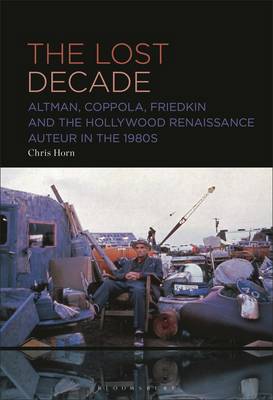
- Afhalen na 1 uur in een winkel met voorraad
- Gratis thuislevering in België vanaf € 30
- Ruim aanbod met 7 miljoen producten
- Afhalen na 1 uur in een winkel met voorraad
- Gratis thuislevering in België vanaf € 30
- Ruim aanbod met 7 miljoen producten
Zoeken
The Lost Decade
Altman, Coppola, Friedkin and the Hollywood Renaissance Auteur in the 1980s
Chris Horn
Hardcover | Engels
€ 203,95
+ 407 punten
Omschrijving
Provides an analysis of Hollywood from a fresh viewpoint that shows the careers of Robert Altman, Francis Coppola, William Friedkin, and others in the 1980s as far from conforming to a monolithic pattern of decline, but rather as diverse and complex responses to political and industrial changes.
The 1980s are routinely seen as the era of the blockbuster and of 'Reaganite entertainment, ' whereas the dominant view of late 1960s and early 1970s American film history is that of a 'Hollywood Renaissance', a relatively brief window of artistry based around a select group of directors. Yet key directors associated with the Renaissance period remained active throughout the 1980s and their work has been obscured or dismissed by a narrow, singular model of American film history.
This book deals with industrial contexts that conditioned these directors' ability to work creatively, but it is also very much about the analysis of individual films, bringing to light a range of unheralded work, from the visual experimentation of One from the Heart (Coppola, 1981) to the experimental production contexts of Secret Honor(Altman, 1984) and the stylistic élanof To Live and Die in L.A. (Friedkin, 1985). Behind the homogenous picture of the decline of the auteur in 1980s American cinema are films and careers that merit greater attention, and this book offers a new way to perceive individual films, American film history, and the viability of sustained authorial creativity within post-studio era Hollywood.
The 1980s are routinely seen as the era of the blockbuster and of 'Reaganite entertainment, ' whereas the dominant view of late 1960s and early 1970s American film history is that of a 'Hollywood Renaissance', a relatively brief window of artistry based around a select group of directors. Yet key directors associated with the Renaissance period remained active throughout the 1980s and their work has been obscured or dismissed by a narrow, singular model of American film history.
This book deals with industrial contexts that conditioned these directors' ability to work creatively, but it is also very much about the analysis of individual films, bringing to light a range of unheralded work, from the visual experimentation of One from the Heart (Coppola, 1981) to the experimental production contexts of Secret Honor(Altman, 1984) and the stylistic élanof To Live and Die in L.A. (Friedkin, 1985). Behind the homogenous picture of the decline of the auteur in 1980s American cinema are films and careers that merit greater attention, and this book offers a new way to perceive individual films, American film history, and the viability of sustained authorial creativity within post-studio era Hollywood.
Specificaties
Betrokkenen
- Auteur(s):
- Uitgeverij:
Inhoud
- Aantal bladzijden:
- 240
- Taal:
- Engels
Eigenschappen
- Productcode (EAN):
- 9781501394454
- Verschijningsdatum:
- 16/11/2023
- Uitvoering:
- Hardcover
- Formaat:
- Genaaid
- Afmetingen:
- 152 mm x 229 mm
- Gewicht:
- 485 g

Alleen bij Standaard Boekhandel
+ 407 punten op je klantenkaart van Standaard Boekhandel
Beoordelingen
We publiceren alleen reviews die voldoen aan de voorwaarden voor reviews. Bekijk onze voorwaarden voor reviews.








